If you’ve noticed that the claws on your cat’s front paws have been gradually darkening, you’re not alone. This is a common problem among cats, and there are several potential causes.
In this article, we’ll explore some of the most likely reasons why this might be happening, and we’ll also provide tips on how to deal with it.
A cat’s claw can darken due to various reasons such as bacterial or fungal infections, trauma to the nail, immune system illnesses, or a buildup of oil and skin cells, and in rare cases, it could be a sign of a cancerous growth on the nail bed.
Why Is My Cat’s Claw Darkening Under?
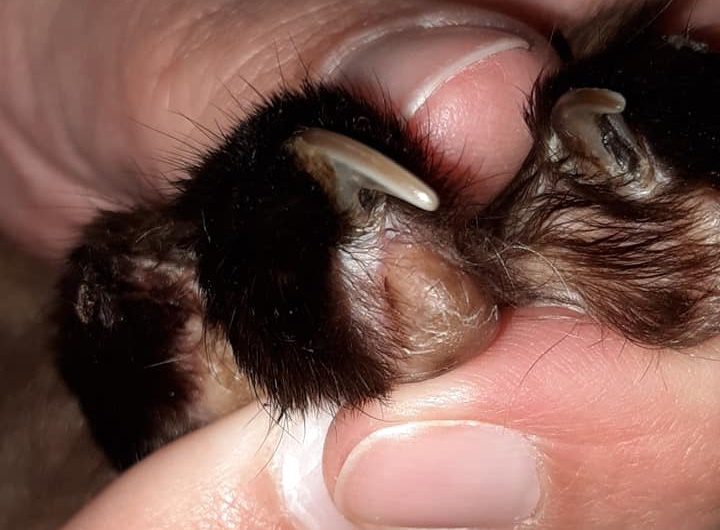
A cat’s claw can start darkening for many reasons. Some of the causes are pretty common and won’t affect the quality of life of your cat.
However, it is always better to be safe than sorry. So, I have come up with a list of seven reasons why your cat’s claw is darkening and what you should do about it:
1. Hyperkeratosis
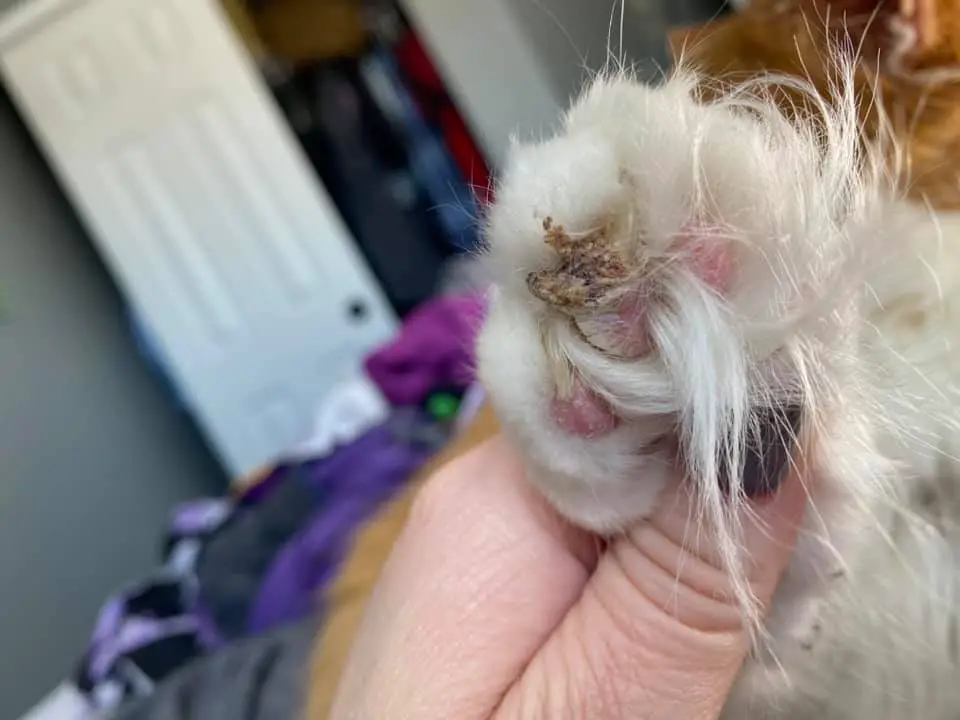
Hyperkeratosis is a medical condition where the body produces too much keratin. This overproduction can cause thickening and darkening of the skin, nails, and hair.
In cats, hyperkeratosis most commonly affects the claws, which can become thickened and darker in color. The condition is not painful or harmful to cats, but it can be unsightly.
Hyperkeratosis is a medical condition where the skin thickens and darkens. It can be caused by a number of things, including exposure to certain chemicals, radiation therapy, or infection.
Cats can develop hyperkeratosis on their claws, which can make them difficult to trim. If you notice your cat’s claws are darkening, you should take them to the vet for an examination.
Hyperkeratosis can be treated by changing the diet or supplements to help reduce the production of keratin. With proper treatment, your cat’s hyperkeratosis should not cause any long-term problems.
The vet may prescribe a medicated shampoo or cream to help treat the condition. In severe cases, surgery may be necessary to remove the affected tissue. With proper treatment, most cats will recover from hyperkeratosis without any lasting effects says MSD Manual.
2. Pemphigus
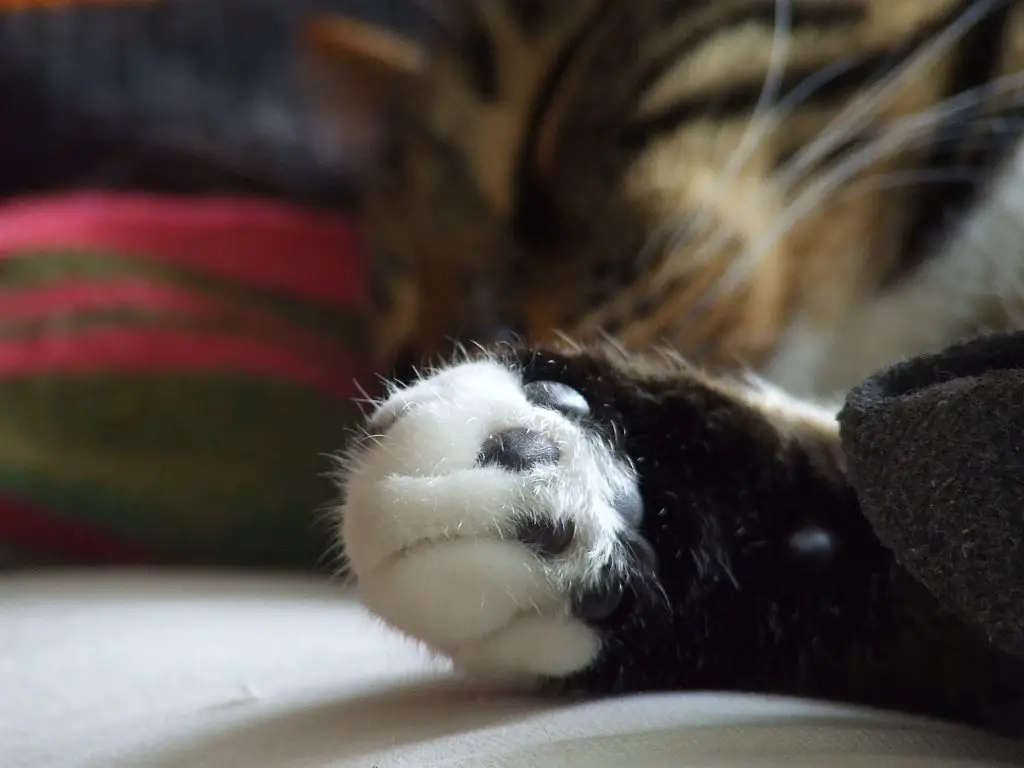
Pemphigus is a serious autoimmune disease that causes the body to attack its own tissues. It can affect different parts of the body, but most commonly affects the skin and nails.
The skin becomes thin and fragile, and blisters and ulcers form. The cat’s claw often starts darkening under. Pemphigus is a very painful condition, and unfortunately, it is often fatal.
There is no known cure for pemphigus, but there are treatments available that can help manage the disease and improve the quality of life for affected cats.
There are a few things you can do to help your cat if it is diagnosed with pemphigus. The first thing is to take them to the vet for treatment.
There are many different treatments available, and the vet will be able to determine the best course of action for your cat. They may also recommend some lifestyle changes, such as switching to a food that is easier to digest or eliminating certain foods from their diet says VCAHospitals.
Samento did a great case study on the antiinflammatory actions of cat’s claw.
3. Fungal or bacterial infections
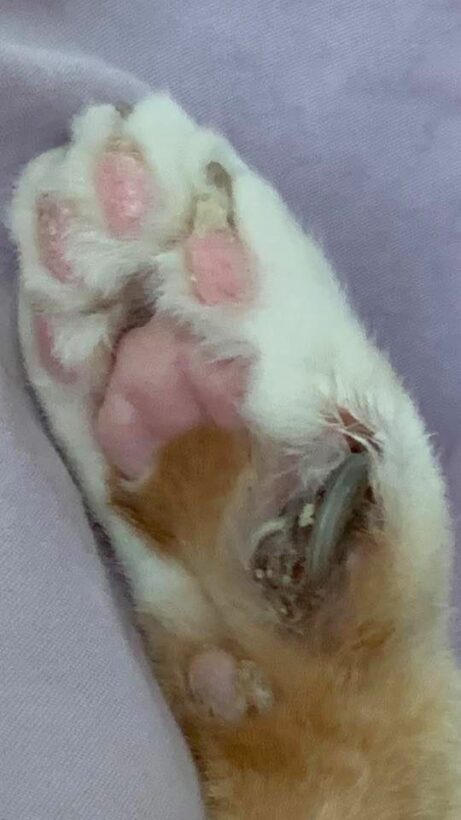
There are four types of infections that can affect your cat: viral, bacterial, fungal, and parasitic. Each type is caused by different organisms and can cause different symptoms. It’s important to know which type your cat has so you can treat it properly.
Fungal infections are caused by fungi, which are tiny plant-like organisms. They’re often found in soil or on plants, and they can cause nail infections, ear infections, or respiratory problems in cats. Fungal infections are more common in humid climates or during the rainy season.
Bacterial infections are caused by bacteria, which are single-celled organisms that can live anywhere—including inside your cat’s body. Bacteria can cause a variety of problems, including nail infections, respiratory infections, and gastrointestinal problems.
If your cat’s claw becomes discolored or darker than usual, this could be a sign of a fungal infection. Fungal infections are relatively common in cats and can be caused by various types of fungi, including yeasts and mold says Vetster.
While most fungal infections are not serious, they can cause discomfort and may lead to more serious problems if left untreated.
There are a few different ways to treat a fungal infection in your cat. Your veterinarian may prescribe antifungal medication, which can be given orally or topically. You will also need to clean your cat’s affected claws daily with an antiseptic solution. In some cases, the nail may need to be removed completely.
The best way to treat a bacterial infection is with antibiotics. Antibiotics can kill the bacteria and help your cat feel better quickly. Be sure to give the full course of antibiotics, even if your cat is feeling better after a few days. Stopping too early can allow the bacteria to continue growing and darken the nail even further says Wag Walking.
4. Genetics
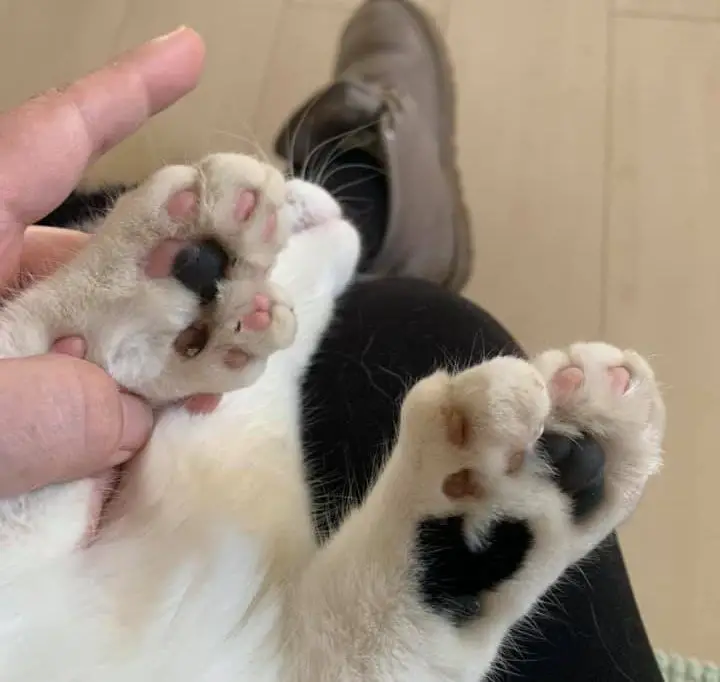
All cats have a gene that codes for the protein needed to make their fur. The gene can have different variations, or alleles, which produce slightly different versions of the protein. One allele produces light-colored fur, while another produces dark-colored fur.
Cats with two copies of the dark allele (DD) will have very dark fur, while those with one copy of the dark allele and one copy of the light allele (DL) will have medium-dark fur. Cats with two copies of the light allele (LL) will have very light fur.
So, how does this relate to a cat’s claw? Well, it turns out that the gene for fur color is also responsible for pigmentation in other parts of the body, including the claws. That’s why you’ll sometimes see dark-colored cats with light-colored claws or vice versa.
5. Injury
If a cat’s claw becomes damaged, it will often darken in color. This is because the outer layer of the claw (the part that you see) is made up of dead cells. When these cells are damaged, they can no longer reflect light as well, resulting in a darker appearance. In some cases, the damage to the cells can be so severe that the entire nail may turn black.
If your cat has a claw injury, the first thing you should do is clean the wound. You can do this by using mild soap and water. Once the wound is clean, you will need to apply an antibiotic ointment to it. After that, you will need to wrap the wound in a sterile gauze pad.
If your cat has a more severe claw injury, it may need to see a veterinarian. The vet may prescribe antibiotics or pain medication for your cat. They may also need to have their claw removed if it is severely damaged.
6. Poor diet
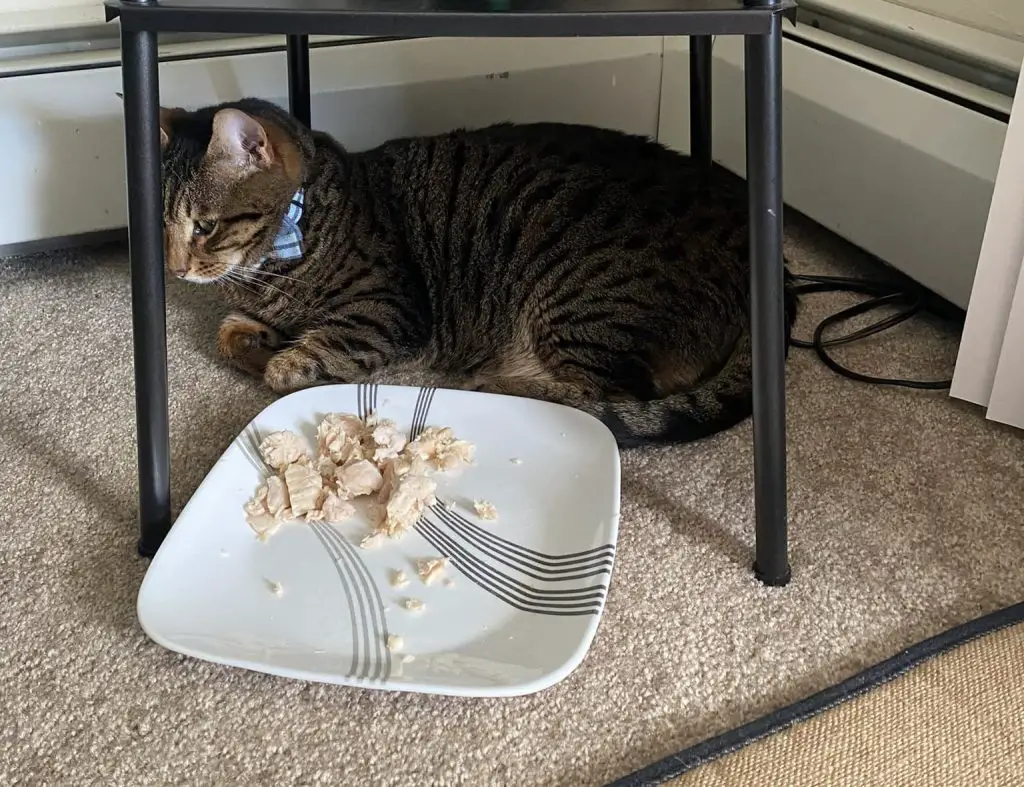
When a cat’s diet is poor, it can lead to discoloration in its claws. This is because the nails are made of keratin, which is a protein. If a cat isn’t getting enough protein in their diet, it can cause the nails to become brittle and break easily. It can also cause the nails to become yellow or brown.
There are a few things you can do to help your cat’s nails stay healthy and strong. Make sure they’re eating a balanced diet that includes plenty of protein. You can also give them supplements specifically designed for cats’ nails. And be sure to trim their nails regularly so they don’t get too long and start breaking.
While a raw diet is best for cats, cooked chicken, turkey, and fish are good protein sources, too. Just make sure they’re boneless and skinless. Cooked eggs are another option. If you feed your cat canned food, look for brands that list meat or fish as the first ingredient.
Avoid foods with lots of grains or corn. And don’t forget to provide fresh water at all times. A healthy diet is an important part of keeping your cat’s claws healthy and strong!
7. Aging
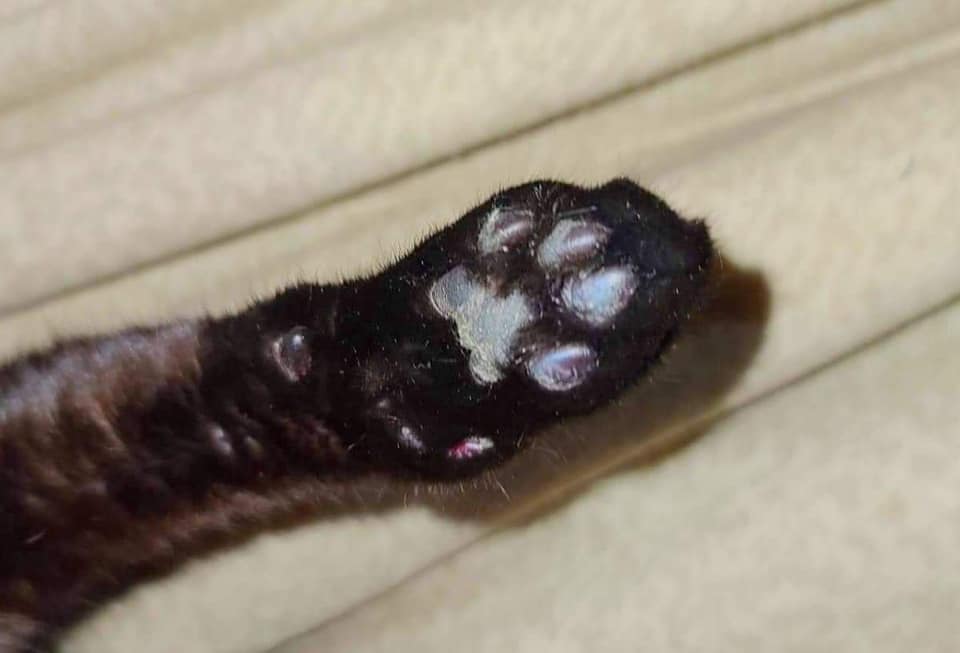
As a cat’s claw darkens with age, the outermost layer of the claw (the eponychium) thickens and becomes less transparent. This process is similar to how human nails become yellow and opaque with age.
The difference in cats, however, is that the claws continue to grow throughout their lifetime. As a result, the darkening of the claws is more pronounced in older cats.
There are several reasons why a cat’s claw might darken with age. One possibility is that it is simply due to the increased thickness of the eponychium. Another possibility is that pigment cells (melanocytes) within the eponychium become more active with age, resulting in a darker coloration.
Finally, it is also possible that the keratinocytes of the eponychium produce more melanin, resulting in a darker color. All of these factors can contribute to the darkening of a cat’s claw with age. In any case, this change is usually not causing for concern and is simply a part of the aging process.
Is your cat suffering from Diarrhea?
Learn how to help your cat fast.
How To Treat Darkening Under Cat’s Claw
To treat darkening under a cat’s claw, it’s necessary to identify the cause and then apply the appropriate treatment, which may include hygiene improvements, dietary changes, or medications.
Improved Hygiene
One possible cause of darkening under a cat’s claw could be a buildup of oil, skin cells, or even litter box dust.
Regular cleaning can help prevent this buildup. Soaking your cat’s feet in warm water and gently brushing around his claws can help keep them clean. If your cat allows it, try to make this a regular part of their grooming routine.
Dietary Changes
Hyperkeratosis, an overproduction of keratin, can also lead to darkening of the claws. This condition can often be treated by changing the cat’s diet or adding supplements to reduce keratin production. Your vet can recommend the best diet or supplements for your cat’s specific needs.
Medications
In some cases, darkening under the claws can be caused by a bacterial or fungal infection. These infections can be treated with oral medications or topical ointments applied directly to the nail. The duration and type of treatment will depend on the severity and type of the infection.
Regular Trimming
If the darkening is due to an overgrowth of nails, regular trimming can help. Overgrown nails can be trimmed by a vet or a professional groomer, or at home if you’re comfortable doing so says Humane Societ.
Veterinary Intervention
For more serious conditions like onychodystrophy or claw fungus, veterinary intervention may be necessary. Your vet may prescribe antibiotics or other treatments depending on the cause of the problem.
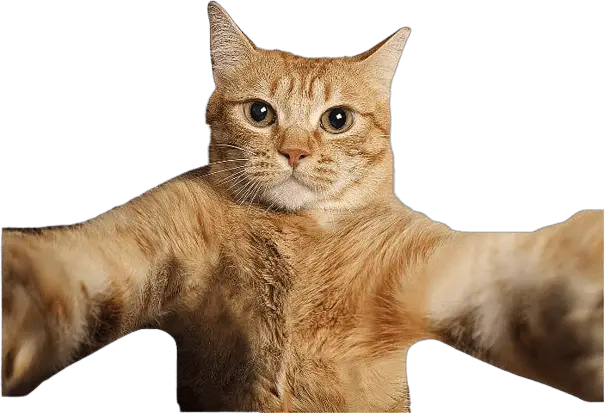
Does your cat just meow all night?
Learn why your cat meows all night and what you can do about it.
How To Prevent Darkening Under Cat’s Claw
To prevent darkening under a cat’s claw, it’s crucial to maintain proper claw hygiene, provide a balanced diet, and regularly inspect for signs of infection or disease.
Regular Claw Trimming
Regular claw trimming is one of the most effective ways to prevent darkening under a cat’s claw. This can be done at home or by a professional groomer or vet. During trimming, start with a cut near the tip to avoid cutting into the quick, which can cause pain and bleeding. Always leave more claw than to cut too deep.
Balanced Diet
A balanced diet can help reduce the production of keratin, a common cause of hyperkeratosis that can lead to darkening of the claws. Providing your cat with a diet rich in essential vitamins and minerals can help maintain the health of their claws and prevent discoloration.
Regular Inspection and Treatment of Infections
Regular inspection of your cat’s claws can help spot signs of infections early. Claw infections can be caused by bacteria or fungus and can lead to darkening of the claws. These infections can be treated with oral medications or topical ointments prescribed by a vet.
Proper Claw Hygiene
Maintaining proper claw hygiene can also prevent the accumulation of dirt and debris under the claw, which can cause darkening. This includes cleaning your cat’s claws regularly and ensuring they have a clean environment to play and rest in.
Gradual Familiarization with Nail Scissors
Gradually familiarizing your cat with nail scissors can make the process of claw maintenance easier and less stressful for both you and your cat. This can be done by first offering treats for checking out the nail scissors, then for touching the feet with the scissors, and finally holding the feet.
What Does a Cat Claw Infection Look Like?
A cat claw infection can manifest in many different forms, with the most common being a swollen or inflamed area around the affected claw.
The paw may also appear red and irritated, and there may be discharge coming from it. In severe cases, pus or even blood may be present.
If an infection is left untreated for too long, it can spread to other areas of the body and cause more serious damage.
It’s important to seek medical attention immediately if you suspect your cat has a claw infection so it can be properly treated.
How Do I Know If My Cat’s Nails Are Healthy?
Healthy cat nails are generally clear, smooth, and free of cracks or discoloration.
Transparency and Color
Healthy cat claws are usually translucent or light in color. Darkening, yellowing, or any other changes in color may indicate an issue such as fungal infection or injury. However, it’s important to note that some cats naturally have darker claws, so it’s essential to know what’s normal for your pet.
Smoothness
A healthy claw is smooth without any rough patches, cracks, or chips. If you notice that your cat’s claws are becoming rough or are breaking easily, this could be a sign of nutritional deficiencies or other health issues.
Comfort Level
Your cat should not show signs of discomfort when their claws are touched or during claw trimming. If they do, this could indicate a problem. Pain or discomfort could be caused by an overgrown claw, injury, or infection.
Absence of Swelling or Redness
Swelling, redness, or warmth around the nail bed can signify an infection or injury. Healthy cat claws will not have these symptoms.
Regular Shedding
Cats naturally shed the outer layers of their claws. This is a healthy process and helps keep their claws sharp. If your cat isn’t shedding its claws regularly, or if the shedding seems excessive, it might be worth discussing with your vet.
Will My Cat’s Nail Heal On Its Own?
Yes, minor injuries to a cat’s nail can often heal on their own, but more serious injuries may require veterinary intervention.
If your cat has a minor injury such as a small crack or chip in the nail, it will typically heal on its own over time.
Cats naturally shed the outer layers of their claws, which can help the healing process. However, it’s important to monitor the injury to ensure it doesn’t worsen or become infected.
Is It Bad To Never Trim Your Cat’s Nails?
Yes, it can be detrimental to never trim your cat’s nails as it can lead to several health and behavioral issues.
Neglecting to trim your cat’s nails can result in overgrown claws. Overgrown claws are not only uncomfortable for your cat, but they can also become ingrown and penetrate the paw pad, causing pain and potential infection.
Additionally, longer nails are more prone to splitting or breaking, which can be extremely painful and may require veterinary treatment.
FAQs
Q: How can I tell if my cat has a cat’s claw darkening under?
A: You may notice that your cat’s claw appears to be darker than usual, or you may see discoloration around the nail bed. If you suspect your cat may have a cat’s claw darkening under, it is best to consult a veterinarian for a proper diagnosis.
Q: Can I trim my cat’s claws if they have a cat’s claw darkening under?
A: It is not recommended to trim your cat’s claws if they have a cat’s claw darkening under, as it could cause further damage or discomfort. It is best to consult a veterinarian for proper treatment.
Q: How are cat’s claw and nail disorders diagnosed?
A: Cat’s claw and nail disorders are typically diagnosed by a veterinarian through a physical examination and potentially taking a sample of the affected area for further testing.
Q: Are cat’s claw and nail disorders common in cats?
A: Cat’s claw and nail disorders can occur in cats, but they are not as common as other cat health issues. However, it is still important for cat owners to be aware of these disorders and seek veterinary care if necessary.
Q: What are some common cat’s claw and nail disorders?
A: Some common cat claw and nail disorders include ingrown nails, fungal infections, bacterial infections, and trauma to the nail.
Q: Can I use a regular clipper to trim my cat’s claws?
A: It is recommended to use a clipper specifically designed for cats to trim their claws. Regular clippers may cause injury or discomfort to your cat.
Q: Is declawing a solution for a cat’s claw and nail disorders?
A: Declawing is not recommended as a solution for a cat’s claw and nail disorders. It is a controversial procedure that involves amputating the tips of a cat’s toes, and it can lead to physical and behavioral problems. There are alternative options for managing a cat’s claw and nail disorders that do not involve declawing.
Conclusion and final thoughts
If you notice that your cat’s claws are darkening under, it may be a sign of hyperkeratosis or other underlying conditions such as bacterial or fungal infections.
It’s essential to provide your cat with regular nail trimming and check for any signs of infection. Creating a comfortable sleeping environment for your cat can also help alleviate any discomfort they may be experiencing.
If the condition persists or worsens, it’s important to consult with a veterinarian for proper diagnosis and treatment.




